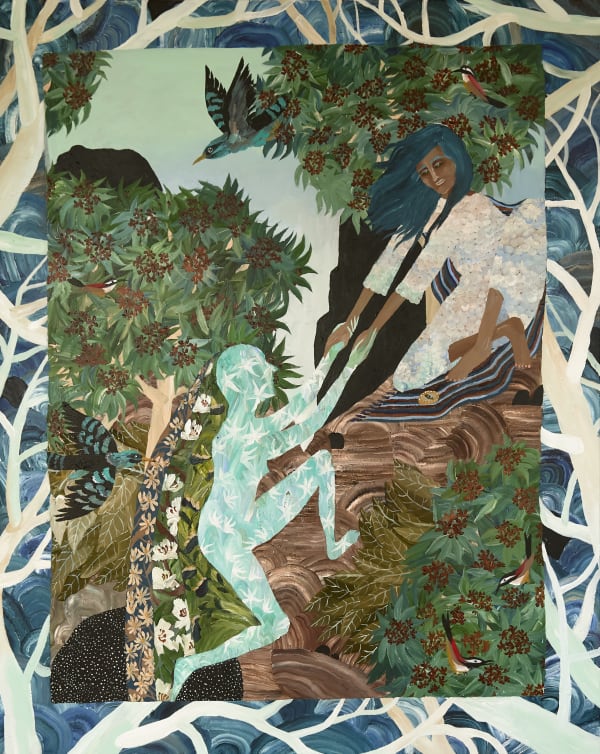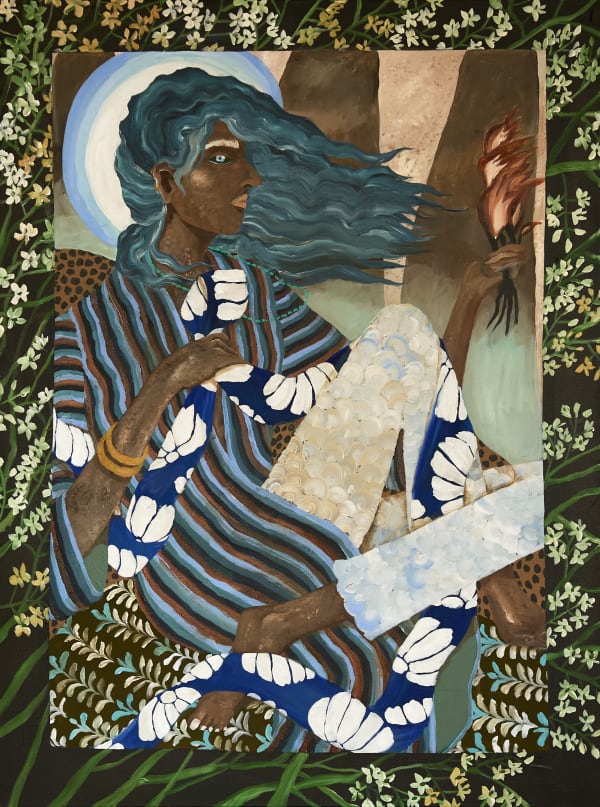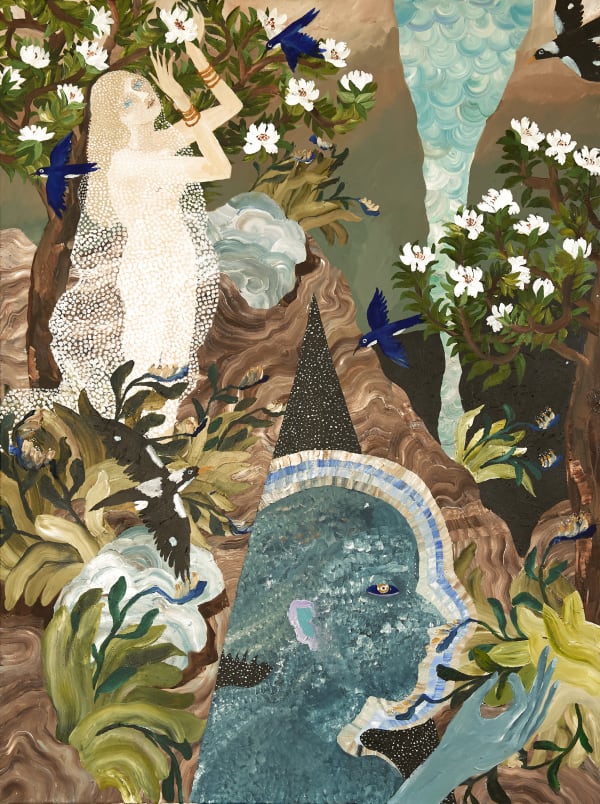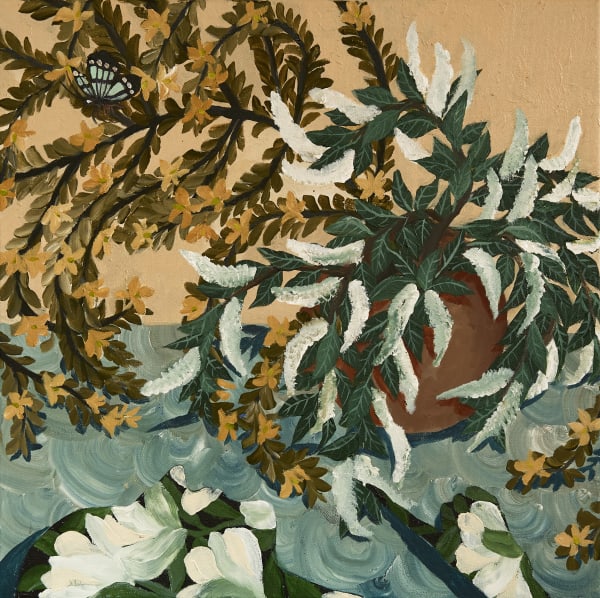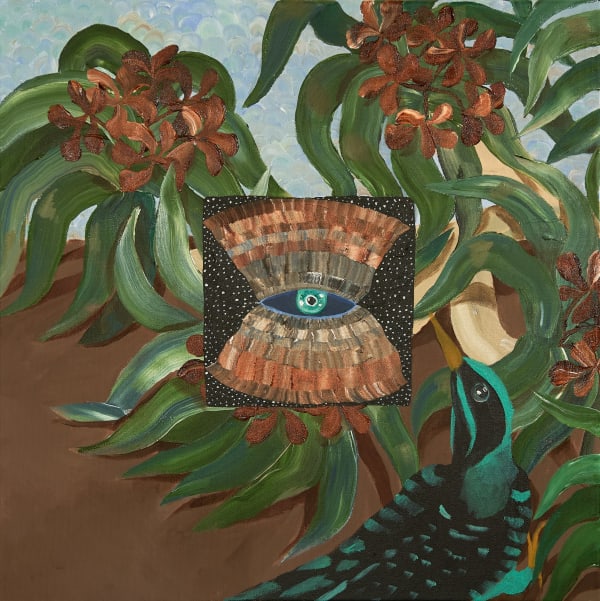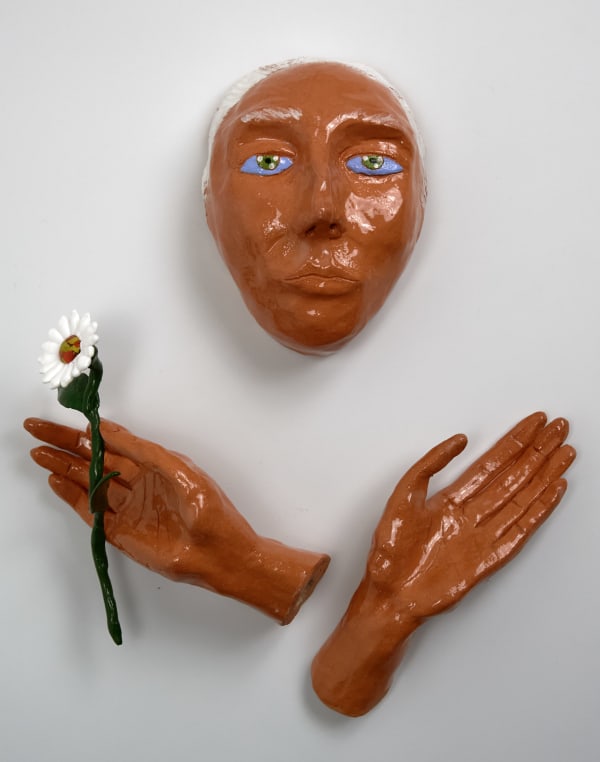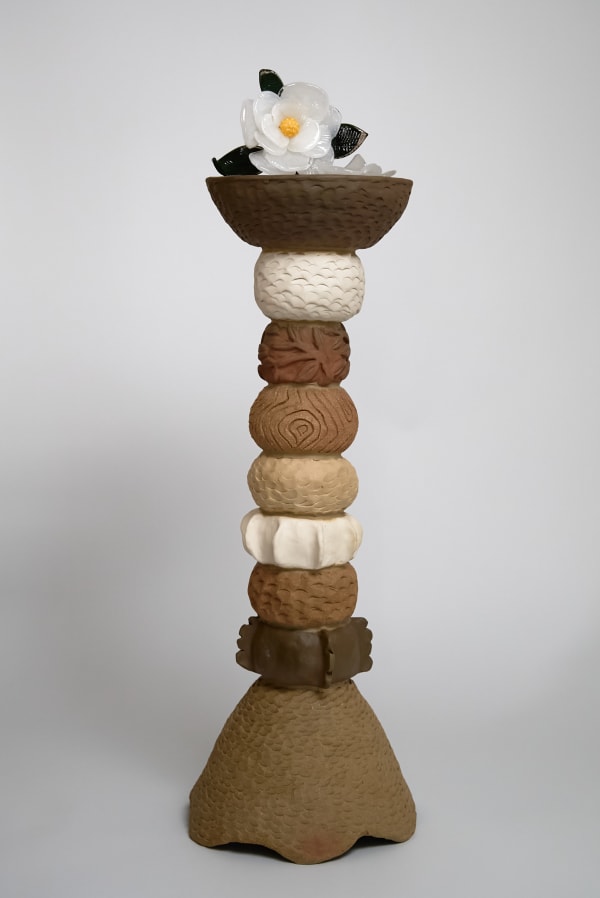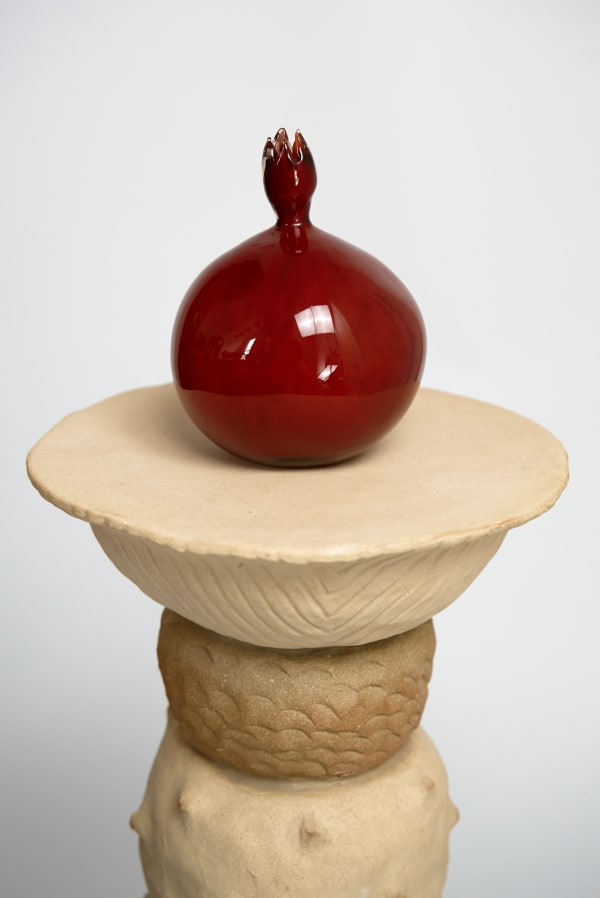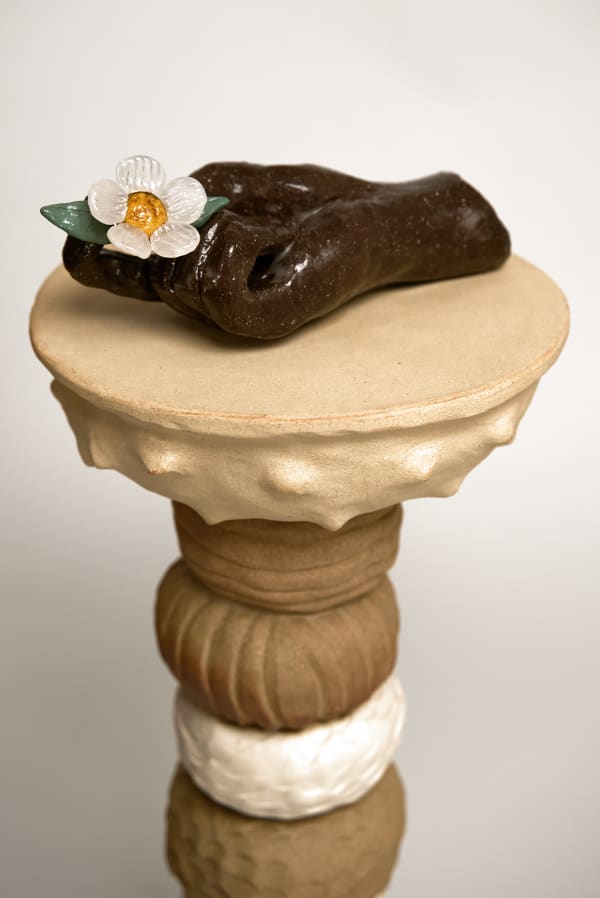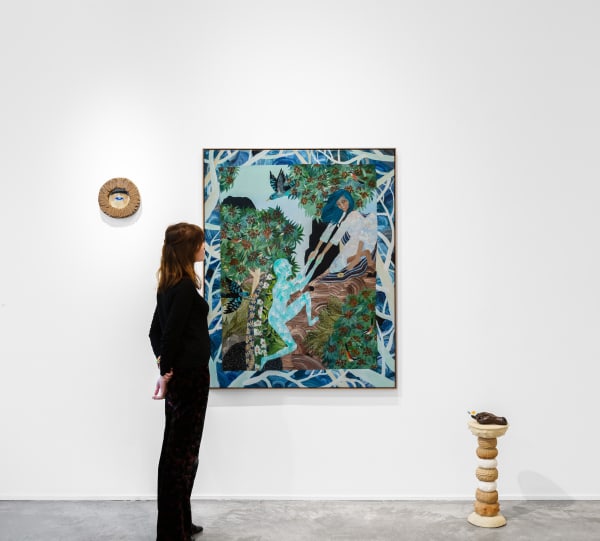Leah Fraser: Persephone's Descent
-
 Leah FraserWherever I start I end up with you, 2025acrylic on canvas152 x 122 cm, 154 x 124 cm (framed)Sold
Leah FraserWherever I start I end up with you, 2025acrylic on canvas152 x 122 cm, 154 x 124 cm (framed)Sold -
 Leah FraserShe would keep returning always and evermore, 2025acrylic on canvas122 x 122 cm, 124 x 124 cm (framed)Sold
Leah FraserShe would keep returning always and evermore, 2025acrylic on canvas122 x 122 cm, 124 x 124 cm (framed)Sold -
 Leah FraserA tongue of knowledge in the feathered night, 2025acrylic on canvas122 x 91 cm, 124 x 93 cm (framed)Sold
Leah FraserA tongue of knowledge in the feathered night, 2025acrylic on canvas122 x 91 cm, 124 x 93 cm (framed)Sold -
 Leah FraserIt was as though she had never seen the sky before, 2025acrylic on canvas122 x 91 cm, 124 x 93 cm (framed)Sold
Leah FraserIt was as though she had never seen the sky before, 2025acrylic on canvas122 x 91 cm, 124 x 93 cm (framed)Sold -
 Leah FraserNo more shall we part, 2025acrylic on canvas122 x 91 cm, 124 x 93 cm (framed)
Leah FraserNo more shall we part, 2025acrylic on canvas122 x 91 cm, 124 x 93 cm (framed) -
 Leah FraserI could not be found, they could not find me, 2025acrylic on canvas122 x 91 cm, 124 x 93 cm (framed)Sold
Leah FraserI could not be found, they could not find me, 2025acrylic on canvas122 x 91 cm, 124 x 93 cm (framed)Sold -
 Leah FraserThis night has opened my eyes, 2025acrylic on canvas122 x 91 cm, 124 x 93 cm (framed)
Leah FraserThis night has opened my eyes, 2025acrylic on canvas122 x 91 cm, 124 x 93 cm (framed) -
 Leah FraserDid I dream you dreamed about me, 2025acrylic on canvas122 x 91 cm, 124 x 93 cm (framed)Sold
Leah FraserDid I dream you dreamed about me, 2025acrylic on canvas122 x 91 cm, 124 x 93 cm (framed)Sold -
 Leah FraserSpring, 2025acrylic on canvas50 x 50 cm, 52 x 52 cm (framed)Sold
Leah FraserSpring, 2025acrylic on canvas50 x 50 cm, 52 x 52 cm (framed)Sold -
 Leah FraserSummer, 2025acrylic on canvas50 x 50 cm, 52 x 52 cm (framed)
Leah FraserSummer, 2025acrylic on canvas50 x 50 cm, 52 x 52 cm (framed) -
 Leah FraserAutumn, 2025acrylic on canvas50 x 50 cm, 52 x 52 cm (framed)Sold
Leah FraserAutumn, 2025acrylic on canvas50 x 50 cm, 52 x 52 cm (framed)Sold -
 Leah FraserWinter, 2025acrylic on canvas50 x 50 cm, 52 x 52 cm (framed)Sold
Leah FraserWinter, 2025acrylic on canvas50 x 50 cm, 52 x 52 cm (framed)Sold -
 Leah FraserThe crossing, 2025glass, ceramic and polymer clay56 x 44 x 21.5 cm (size variable)
Leah FraserThe crossing, 2025glass, ceramic and polymer clay56 x 44 x 21.5 cm (size variable) -
 Leah FraserSee you on the other side, 2025ceramic20 x 12 x 9 cm
Leah FraserSee you on the other side, 2025ceramic20 x 12 x 9 cm -
 Leah FraserLovers eye II, 2025acrylic on canvas with ceramic frame29 ⌀ x 4.5 cm
Leah FraserLovers eye II, 2025acrylic on canvas with ceramic frame29 ⌀ x 4.5 cm -
 Leah FraserLovers eye I, 2025acrylic on canvas with ceramic frame26 ⌀ x 3.5 cm
Leah FraserLovers eye I, 2025acrylic on canvas with ceramic frame26 ⌀ x 3.5 cm -
 Leah FraserLonging, 2025glass23 x 23 x 14 cmSold
Leah FraserLonging, 2025glass23 x 23 x 14 cmSold -
 Leah FraserLonging (plinth), 2025ceramic83.5 x 30 x 30 cm (plinth)
Leah FraserLonging (plinth), 2025ceramic83.5 x 30 x 30 cm (plinth) -
 Leah FraserSeduction, 2025ceramic and polymer clay22 x 7 x 6 cm
Leah FraserSeduction, 2025ceramic and polymer clay22 x 7 x 6 cm -
 Leah FraserSeduction (plinth), 2025ceramic72 x 27.5 x 27.5 cm
Leah FraserSeduction (plinth), 2025ceramic72 x 27.5 x 27.5 cm -
 Leah FraserTemptation, 2025glass16 x 16 x 13 cm
Leah FraserTemptation, 2025glass16 x 16 x 13 cm -
 Leah FraserTemptation (plinth), 2025ceramic62.5 x 28 x 28 xm
Leah FraserTemptation (plinth), 2025ceramic62.5 x 28 x 28 xm -
 Leah FraserReturn, 2025polymer clay and glass22 x 14 x 11 cm
Leah FraserReturn, 2025polymer clay and glass22 x 14 x 11 cm -
 Leah FraserReturn (plinth), 2025ceramic58.5 x 24.5 x 24.5 cm
Leah FraserReturn (plinth), 2025ceramic58.5 x 24.5 x 24.5 cm
Leah Fraser’s work has often been an interplay and evocation of other worlds unseen by our own, drawing us into these alternate planes. The realm of mystical, allegorical and spiritual entwine with the feminine experience through whimsical figuration and imaginings of flora and fauna. Working from her studio in Bronte, Sydney, Fraser is a multi-disciplinary artist with painting, sculpture, ceramics and drawing forming her practice.
In her new exhibition, ‘Persephone’s Descent’ Fraser depicts the story of Persephone, Hades and Demeter, a Greek myth that has evolved into various meanings and etiological interpretations. The origins of the story, centre around Persephone and her mother Demeter, Goddess of the Harvest and Fertility, her father Zeus and Hades, God of the Underworld. A mother and daughter with a close bond intricately tied to the seasons of the Earth, the story has shifted and evolved over time with readings from fertility, love, and as well as feminine identity and autonomy. Characterised as a dark, brooding and complex figure, Hades captures Persephone, pulling her down into the Underworld to take as his wife. Demeter’s reaction is swift and in devastation over the loss of her daughter, brings Winter on the Earth ceasing the cycles of nature and growth. Zeus, realising that Demeter’s grief is interfering with the natural order of things, and in turn his chances of manipulating mortals and their fates, instructs Hades to return Persephone. Irritated by this proposition, Hades declares that she can only return if she has not eaten any food in the Underworld, knowing that he has already tempted Persephone with the pomegranate fruit. She has eaten six seeds from the lush fruit, and can therefore only return to Earth for six months each year leading Demeter to plunge the Earth into Winter and Autumn for half of the year and on Persephone’s return Summer and Spring awaken.
For Fraser, the story takes on one of maternal figures, the bond of mothers and daughters and the strength and transformation of women when faced with oppression, trauma and loss. The narrative has often been a subject of fascination for artists throughout art history; Gabriella Rosetti, John Waterhouse and Frederic Leighton have all created works around Persephone’s journey to the Underworld where she is often the victim; passive and at the mercy of fate. One depiction of Persephone in command is that of Rosetti’s ‘Proserpine’; cloaked in blue she clutches a pomegranate, the fruit of her downfall but also the reason for her return to Earth for six months and the reunification with her mother, Demeter. Fraser’s interpretation is similar with her Persephone being an active participant in the story with agency and determination. Her journey is transformative, with a slow seduction into desire. In these paintings, Demeter, Persephone and Hades alternate as the protagonists, offering their perspectives on the story to the viewer with the matriarch Demeter, becoming the figure for which Persephone and Hades oscillate. Fraser’s Persephone bridges the two worlds – Earth and the Underworld, and moves freely between them.
Demeter has often been shown as an angry and resentful figure who brings Winter on the Earth forever in the grief of her lost daughter. Fraser’s Demeter is ethereal and gentle, gripped with sadness and shock but with an underlying firm resilience. She is ever present in the work, dipping in and out of the paintings, searching for her lost daughter. A sense of devastation yet with an awareness that Persephone is simply on another spiritual plane, forever connected yet remaining unseen to her maternal gaze; the veil between life and death transparent and tangible. We can see this in A tongue of knowledge in the feathered night, Demeter is in the foreground, sensing her daughter’s presence between the two worlds. The hand of the Gods appears above, manipulating and controlling their fate. Demeter is captured aghast, feeling the energy of Persephone as she rides through the landscape on Hades horse. Sidney Nolan’s work as well as Indian miniature paintings were a major influence for this exhibition, and that can be seen in this work, where the horse cuts through the middle ground, engulfed by landscape. Fraser’s separation of the story into eight paintings is similar to the way in which Nolan depicted the story of Ned Kelly. Turning the narrative into a visual poem, Fraser like Nolan draws the viewer into one of imagination and play, guiding us to engage with the emotion of the story. We can choose who will guide us – Persephone, Hades or Demeter, and can switch between the protagonist with each painting.
The compositions of Fraser’s work have often been non-linear and multi-layered much like the worlds she is depicting. Ethereal figures wrap, encircle and dissolve into the other their hands grasping and intertwining, delicate and fragile, reaching in offering while their skin is concealed in intricately patterned fabric resembling the flora and fauna around them, merging in osmosis with their surroundings. The eyes of the spirit figures accompanying Hades and Persephone on their descent to the Underworld are surrounded by Fraser’s feather like mark making resembling orbs of light or the sensation of the rhythmic fluttering of the Earth’s vibrations.
Ceramics and glass work also form part of the exhibition, with both practices involving intense heat and flame recalling the heat of the Earth’s core; the ‘home’ that Persephone now resides in. Their clay forms are delicate and feminine, circular womb like vessels, with death masks of renewal and votive plinths recalling columns of Ancient Greece. Heat and fire, just like the sun warming the seeds of new growth, brings new life and creation, echoing the story of Demeter, Persephone and their influence on the seasons. Just as the story of Persephone’s descent to the Underworld is laden with delicate and multifaceted meanings, so too is Fraser’s practice, with this exhibition a transformative interplay between her paintings, ceramics and glass sculptures that delve into concepts and forms of female identity, the innate nature of womanhood and our connection to the cycles of the Earth.
- Emily George
